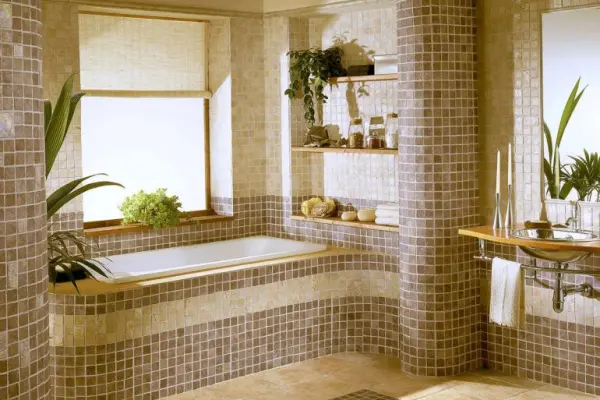Mosaic tiles in the bathroom are a solution that combines functionality and aesthetics. In 2025, 62% of designers use mosaics for accent zones, and the cost of high-quality mosaic bathroom cladding starts at $8-12 per square foot for ceramic options. Decorating a bathroom with mosaics allows for the creation of a unique space where every element contributes to the overall concept. It’s worth noting that bathroom mosaics require a special approach to material selection and installation techniques—like tuning a musical instrument, every detail matters.
A bathroom interior with mosaics becomes akin to a precious jewelry box. Each element plays a role in the overall composition, creating a symphony of light and color. In practice, I often notice that properly selected mosaic tiles transform a bathroom’s design, turning a utilitarian space into an oasis of calm. But how do you choose the right material among the many options?
“In one of my recent projects in New York, I used blue-green glass mosaics to create a marine-themed panel. The clients noted that the bathroom became a place of relaxation, and the mosaic star on the wall reminded them of their travels. The result exceeded expectations—the space gained individuality and functionality.” — Sarah Miller, interior designer
Types of Mosaic Tiles for Bathrooms
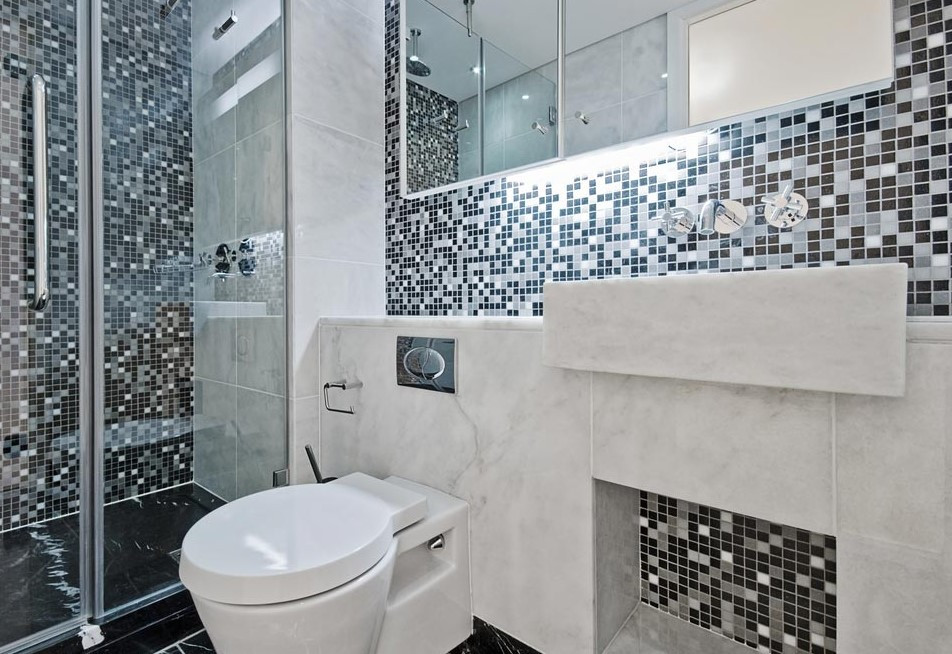 Modern types of mosaic tiles offer vast possibilities. Choosing the material is a key aspect of the project. It’s not always easy to decide among numerous options, but the right choice pays off with decades of flawless service and aesthetic pleasure.
Modern types of mosaic tiles offer vast possibilities. Choosing the material is a key aspect of the project. It’s not always easy to decide among numerous options, but the right choice pays off with decades of flawless service and aesthetic pleasure.
Glass mosaic bathrooms are the top choice among designers due to their moisture resistance and decorative properties. These materials account for 30% of the finishing solutions market. It’s known that glass surfaces do not absorb moisture and are easy to clean, which is especially important in humid environments.
Ceramic mosaic bathrooms are preferred for their affordability and variety of textures. This type of cladding holds 45% of the market due to its optimal price-to-quality ratio. In one recent project, ceramic mosaics enabled the creation of a luxurious interior on a limited budget.
The following table will help you navigate the characteristics of different materials and make an informed choice based on budget and operational requirements.
| Material Type | Moisture Resistance | Price per Sq. Ft. | Installation Complexity | Durability (Years) | Slip Resistance Class |
|---|---|---|---|---|---|
| Glass Mosaic | Excellent | $12-35 | Medium | 40-50 | R9-R10 |
| Ceramic Mosaic | Good | $8-20 | Easy | 25-35 | R10-R11 |
| Natural Stone | Good | $20-45 | High | 30-40 | R11-R12 |
| Metallic Mosaic | Moderate | $25-60 | High | 15-20 | R9 |
This table will help you navigate the characteristics of different materials and make an informed choice based on budget and operational requirements.
Mosaic Sizes and Chip Shapes for Bathrooms
The size of bathroom mosaics determines the character of the future interior. Standard elements are produced in sizes of 10×10, 15×15, 20×20, and 25×25 mm, per international standards. Considering the structural features of the room, smaller 10×10 mm chips are better suited for creating detailed patterns and cladding curved surfaces, enabling the realization of the boldest design ideas.
Mosaic chip shapes include classic squares, rectangles, hexagons, and unique geometric variants. In my work with private clients, I’ve noted the growing popularity of hexagonal mosaics. They create a honeycomb effect and add dynamism to the space. This solution is particularly striking in modern interiors.
Expert Tip: “For small bathrooms, choose mosaics no larger than 15×15 mm. Smaller elements visually expand the space and create a sense of depth. Avoid contrasting grout lines—they fragment the surface.”
Surface Preparation and Waterproofing for Mosaics
.jpg) Surface preparation is the foundation of a successful project. The base must be leveled with deviations of no more than 1 mm per 2 meters of length, per building standards. Any unevenness will become a noticeable defect after laying small elements, so skimping on preparatory work is unacceptable. Concrete bases must have a strength class of at least B15.
Surface preparation is the foundation of a successful project. The base must be leveled with deviations of no more than 1 mm per 2 meters of length, per building standards. Any unevenness will become a noticeable defect after laying small elements, so skimping on preparatory work is unacceptable. Concrete bases must have a strength class of at least B15.
Waterproofing wet zones includes treating wall-to-floor joints, corners, and areas adjacent to plumbing fixtures. Thus, high-quality waterproofing prevents moisture penetration and extends the coating’s lifespan by decades. Considering the specifics of bathrooms, elastic polyurethane mastics or roll-type bitumen-polymer materials are used, which compensate for thermal deformations of the base and ensure reliable leak protection.
Technical Requirement: “For cladding areas over 25 m², temperature joints of 5-8 mm wide must be installed every 6 meters. Reinforcing internal corners with fiberglass mesh prevents crack formation during use.”
Features of Mosaic Installation in Bathrooms
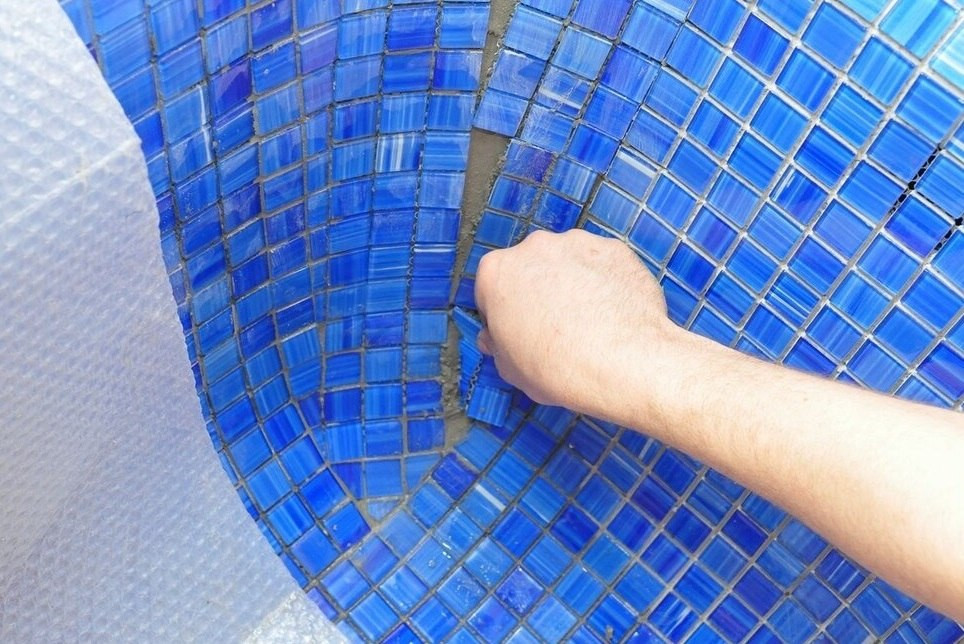 Installing mosaics in a bathroom resembles a jeweler’s work—every detail matters. The process requires patience and precision. Matrix mosaics on mesh simplify installation, and modern manufacturers supply material in 30×30 cm sheets, speeding up the process 3-4 times compared to piece-by-piece laying.
Installing mosaics in a bathroom resembles a jeweler’s work—every detail matters. The process requires patience and precision. Matrix mosaics on mesh simplify installation, and modern manufacturers supply material in 30×30 cm sheets, speeding up the process 3-4 times compared to piece-by-piece laying.
The technology includes several critical stages. Moisture-resistant mosaic adhesive is chosen in white for glass elements to avoid dark base show-through. Pre-treating the base with a special primer to improve adhesion is mandatory. Detailed installation techniques for various bases can be studied in a practical guide to laying mosaics on concrete bases. Mosaic grout is applied using epoxy compounds resistant to moisture and chemicals, with mandatory antifungal additives.
Design Solutions and Style Directions
Mosaics in interiors create an atmosphere of refined luxury or cozy domestic warmth. The choice of style defines the space’s character. In modern minimalism, monochrome solutions with geometric shapes dominate, while classic styles favor natural stone shades and intricate patterns, evoking a sense of timelessness and stability.
Mosaic colors in interiors affect space perception and the room’s overall atmosphere. It’s known that blue and green tones promote relaxation and create a sense of freshness. Warm beige and creamy shades foster comfort and security. Combining mosaics with large tiles is a popular 2025 trend, reducing project costs by 30-40% while maintaining a designer effect.
It’s important to consider mosaic compatibility with underfloor heating systems. Ceramic and glass mosaics conduct heat well but require gradual heating with a maximum increase of 5°C per day to prevent thermal deformations.
Accent Zones and Bathroom Mosaic Finishing
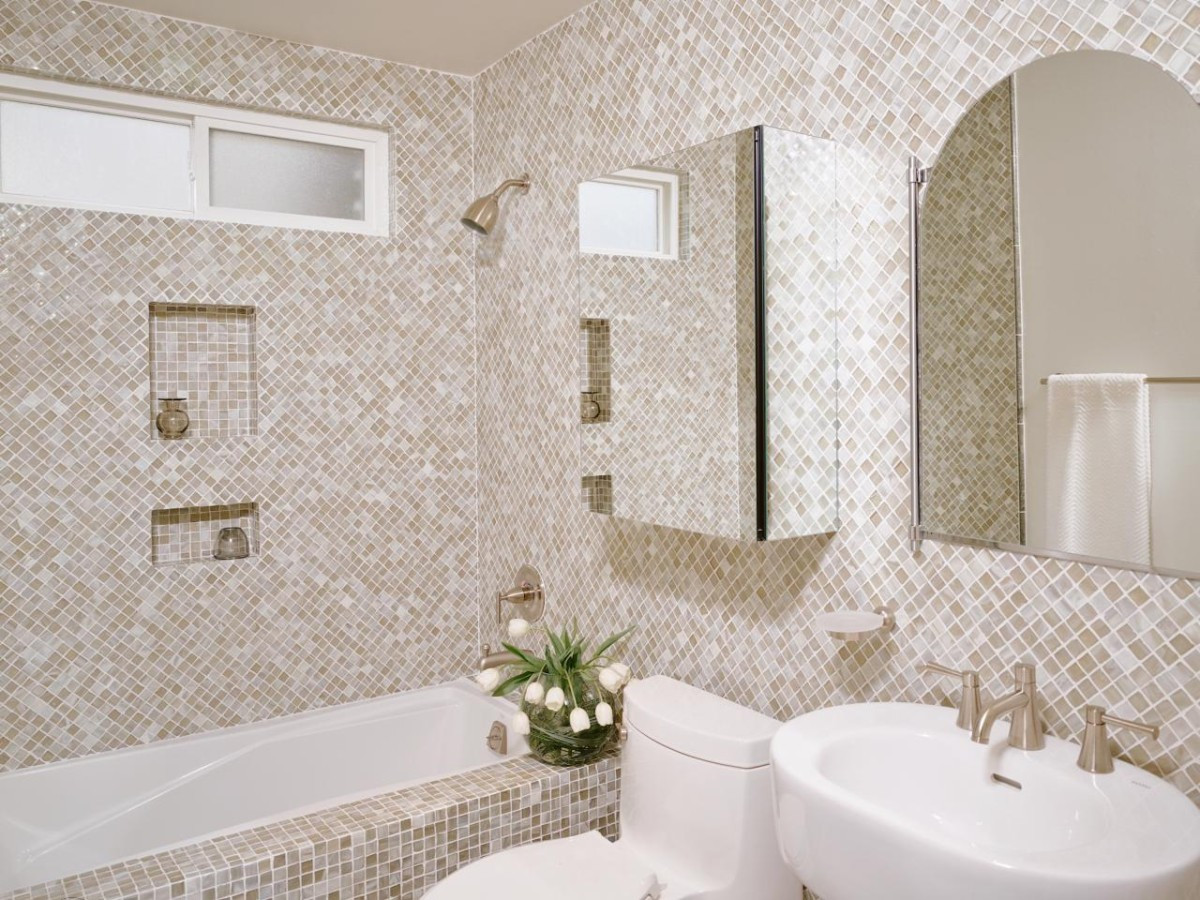 Mosaic accent walls are a popular 2025 solution among leading designers. Zoning a bathroom with mosaics allows for highlighting functional areas: the shower zone, sink area, or storage niche. This approach creates a visual hierarchy and makes the space more organized.
Mosaic accent walls are a popular 2025 solution among leading designers. Zoning a bathroom with mosaics allows for highlighting functional areas: the shower zone, sink area, or storage niche. This approach creates a visual hierarchy and makes the space more organized.
A mosaic sink backsplash creates a practical and beautiful work zone. In a project last season, we used pearlescent mosaics to frame a mirror. The effect was stunning in any lighting. Mosaic bathroom panels allow for creating true artworks on walls, and modern block mosaic sheets simplify complex designs without requiring artistic skills.
Practical Tip: “Use the 60-30-10 rule when choosing mosaic colors: 60% neutral background, 30% complementary color, 10% bright accent. This creates a harmonious composition without visual chaos.”
Economic Aspects and Budget Planning
The cost of mosaic installation includes materials ($8-45 per sq. ft.) and labor ($18-35 per sq. ft., depending on the region). Self-installation saves up to 50% of the budget but requires experience and time. Where can you buy quality bathroom mosaics affordably? Professional installation guarantees results but significantly increases project costs.
The long-term economic efficiency of mosaics includes not only initial costs but also maintenance expenses. With a lifespan of 25-40 years and annual maintenance costs of $50-100, the total cost is $4-8 per sq. ft. per year. Quality mosaics increase property value by 3-5% and provide a unique aesthetic effect.
Common Mistakes When Working with Mosaics
Planning errors often lead to material and time overruns. The main issue is miscalculating quantities. Always include a 10-15% reserve for cuts and potential defects, as sourcing the exact same batch later can be challenging.
Technical errors include using unsuitable adhesive, improper base preparation, and rushing grout application. In one project, 40% of the work had to be redone due to using standard tile adhesive instead of a specialized mosaic compound. The result was disastrous. Such mistakes can be avoided by following proper techniques.
Professional Tip: “Three main beginner mistakes: skimping on materials, rushing grout application, and ignoring temperature joints. Quality mosaics, with proper technique, last 25-40 years. Always observe a 24-hour technical break between installation and grouting.”
Anti-Slip Mosaic for Floors and Practical Aspects
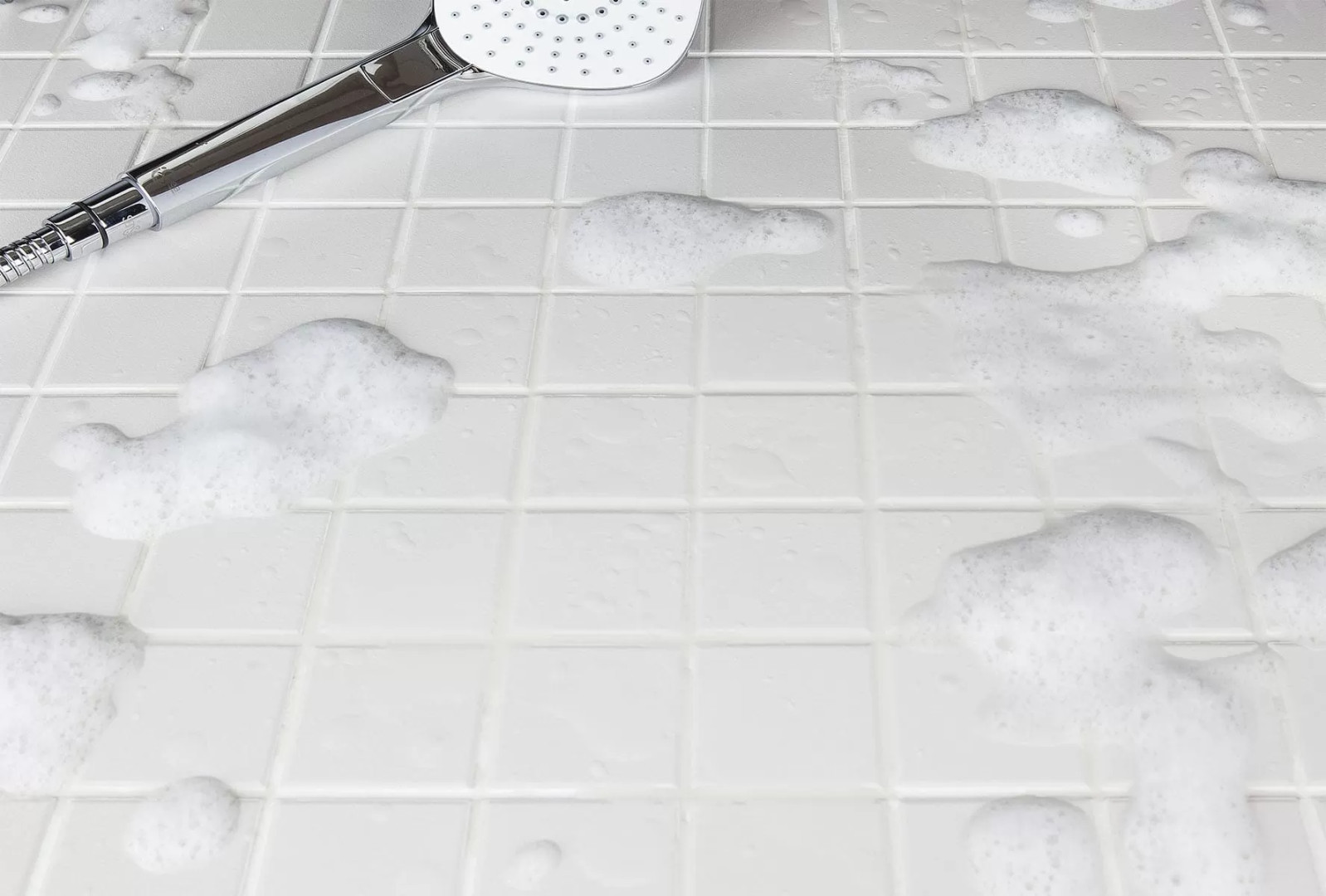 Anti-slip mosaic flooring ensures safety in high-humidity conditions. Coverings with slip resistance classes R10-R12 significantly reduce fall risks compared to smooth tiles. Matte and textured surfaces are especially important in shower zones and near bathtubs.
Anti-slip mosaic flooring ensures safety in high-humidity conditions. Coverings with slip resistance classes R10-R12 significantly reduce fall risks compared to smooth tiles. Matte and textured surfaces are especially important in shower zones and near bathtubs.
Bathroom mosaic finishing requires consideration of operational loads and sanitary-hygienic requirements. The moisture resistance of mosaic cladding depends on material quality, grout application, and installation technique adherence. With proper installation and regular maintenance, bathroom mosaic durability reaches 25-40 years, depending on the material.
Recent years have seen a trend toward large-format floor mosaics—20×20 and 25×25 mm elements reduce grout lines and simplify surface maintenance. Modern cleaning and maintenance methods are detailed in a professional guide to mosaic tile maintenance.
Decorating a bathroom with mosaic tiles opens endless possibilities for creativity and creating a unique space. The right material choice, professional installation, and proper maintenance ensure your bathroom’s durability and beauty for decades. Mosaic bathroom finishing transforms an ordinary room into a work of art. By following expert recommendations and considering each mosaic type’s specifics, you’ll create not just a functional space but a true oasis of comfort and style in your home.
